![か – Forming Questions and Saying “Or” in Japanese [JLPT N5]](http://hirakan.com/cdn/shop/articles/ka-questions.jpg?v=1763787134&width=1100)
か – Forming Questions and Saying “Or” in Japanese [JLPT N5]
Aktie
Quick Summary
- Meaning: The particle か turns a sentence into a question, or can mean “or” when choosing between things.
- How to Use: Put か at the end of a sentence for questions, or between two choices to say “A or B”.
Example:
- おじいさんは宇宙人ですか。
- Ojiisan wa uchuujin desu ka.
- Is grandpa an alien?
Overview
The particle か is one of the first and most important particles you will meet in Japanese. It has two core jobs:
- To make a yes/no question or wh-question (who, what, where, etc.).
- To connect two things with the meaning “or”.
In English, you usually show a question with word order and a question mark:
- Are you a student?
In Japanese, you keep the normal sentence order and simply add か at the end of the sentence to show it is a question. The question mark is often added in modern writing, but the real “question mark” in Japanese is the particle か itself.
For example, a normal statement:
- ロボットは先生です。
- Robotto wa sensei desu.
- The robot is a teacher.
Now add か to turn it into a question:
- ロボットは先生ですか。
- Robotto wa sensei desu ka.
- Is the robot a teacher?
You can also use か in the middle of a sentence to connect choices, like “A or B”. This is very common with nouns and short phrases, especially when you are asking someone to choose.
Because か is so simple and regular, it is a friendly grammar point for beginners. Learn it well, and suddenly you can ask all kinds of questions in Japanese, from normal ones to very strange ones like:
- この猫は人間ですか。
- Kono neko wa ningen desu ka.
- Is this cat a human?
Structure / Formation
1. Making Yes/No Questions with か
The basic pattern to make a yes/no question is:
- Sentence + か
Here, “Sentence” can be many things: a noun sentence, a verb sentence, or an adjective sentence. You just keep the normal form, and then add か at the end.
Common base patterns:
- N + です + か
- V (polite) + か e.g. V-ます + か
- i-adj + です + か (optional です)
- na-adj + です + か
Think of it like this: you first make the normal polite sentence, then you “stick” か to the end to ask.
| Type | Statement | Question |
|---|---|---|
| Noun | ロボットは学生です。 Robotto wa gakusei desu. The robot is a student. |
ロボットは学生ですか。 Robotto wa gakusei desu ka. Is the robot a student? |
| Verb | 私は飛びます。 Watashi wa tobimasu. I fly. |
私は飛びますか。 Watashi wa tobimasu ka. Do I fly? |
| i-adj | このケーキはあまいです。 Kono keeki wa amai desu. This cake is sweet. |
このケーキはあまいですか。 Kono keeki wa amai desu ka. Is this cake sweet? |
| na-adj | おじいさんは元気です。 Ojiisan wa genki desu. Grandpa is energetic. |
おじいさんは元気ですか。 Ojiisan wa genki desu ka. Is grandpa energetic? |
Example:
- あなたは忍者ですか。
- Anata wa ninja desu ka.
- Are you a ninja?
In casual spoken Japanese, people often drop です and even か, using just a rising intonation. But at the N5 level and in polite speech, it is best to keep です and か as in the patterns above.
2. Using Question Words with か
You also use か with question words like:
- だれ (who)
- なに / なん (what)
- どこ (where)
- いつ (when)
- どうして (why)
- どれ / どの (which)
The basic idea is the same:
- Question word + … + か
Just build the sentence normally, replace the unknown part with a question word, and finish the sentence with か.
| Pattern | Example |
|---|---|
| だれ + が / は + ~ + か |
だれが先生ですか。 Dare ga sensei desu ka. Who is the teacher? |
| どこ + Place + か |
トイレはどこですか。 Toire wa doko desu ka. Where is the toilet? |
| なに / なん + を + V-ま + す + か |
あなたはなにを食べますか。 Anata wa nani o tabemasu ka. What do you eat? |
Example:
- だれが月でピクニックをしますか。
- Dare ga tsuki de pikunikku o shimasu ka.
- Who is having a picnic on the moon?
Notice how the only thing that always stays the same in these questions is the final か. This makes it a very reliable marker for questions.
3. Using か for Choices: “A or B”
か can also join two options with the meaning “or”. This is most common with nouns for beginners.
Basic patterns:
- N1 か N2
- N1 か N2 か (when listing more choices, the last か is often followed by どれ / どれですか, etc.)
This can be used inside a question, or even inside a statement.
| Type | Pattern | Example |
|---|---|---|
| Question | N1 か N2 + か |
コーラか水か。 Koora ka mizu ka. Cola or water? |
| Question (full) | N1 か N2 + ですか |
ペンか刀かどちらがほしいですか。 Pen ka katana ka dochira ga hoshii desu ka. Which do you want, a pen or a sword? |
| Statement | N1 か N2 + です |
きょうの晩ご飯はカレーかラーメンです。 Kyou no bangohan wa karee ka raamen desu. Tonight’s dinner is curry or ramen. |
Example (inside a question):
- あなたの友だちは魔法使いかロボットですか。
- Anata no tomodachi wa mahoutsukai ka robotto desu ka.
- Is your friend a wizard or a robot?
When you use か like this, the nuance is that you are offering clear options. It feels like saying “this or that?” in English.
4. か with Clauses (Preview)
At higher levels, か can also connect whole clauses (full sentences) to mean things like “whether A or B”. For example:
-
行くか帰るか決めます。
Iku ka kaeru ka kimemasu.
I will decide whether to go or go home.
For now, as an N5 learner, focus on these two key uses:
- Sentence + か for questions.
- N1 か N2 for “A or B”.
With just these, you can already ask many fun questions in Japanese, from “Are you a student?” to “Is your cat the boss of this company?”:
- この会社の社長は猫ですか。
- Kono kaisha no shachou wa neko desu ka.
- Is the president of this company a cat?
Example Sentences
- この先生は宇宙人ですか。
- Kono sensei wa uchuujin desu ka.
- Is this teacher an alien?
- だれが火星でサッカーをしますか。
- Dare ga kasei de sakkaa o shimasu ka.
- Who plays soccer on Mars?
- 朝ご飯はパンか寿司かどちらですか。
- Asagohan wa pan ka sushi ka dochira desu ka.
- For breakfast, is it bread or sushi?
- あなたのおじいさんは忍者か魔法使いですか。
- Anata no ojiisan wa ninja ka mahoutsukai desu ka.
- Is your grandpa a ninja or a wizard?
- ロボットは犬と話しますか。
- Robotto wa inu to hanashimasu ka.
- Does the robot talk with dogs?
Quick Practice
(Answers and explanations are right under this section.)
Multiple-Choice
1. Choose the correct question: “Is your cat a teacher?”
- A. あなたの猫は先生です。(Anata no neko wa sensei desu.)
- B. あなたの猫は先生か。(Anata no neko wa sensei ka.)
- C. あなたの猫は先生ですか。(Anata no neko wa sensei desu ka.)
- D. あなたの猫は先生と。(Anata no neko wa sensei to.)
2. Choose the best sentence for: “Is it coffee or tea?”
- A. コーヒーとお茶ですか。(Koohii to ocha desu ka.)
- B. コーヒーかお茶ですか。(Koohii ka ocha desu ka.)
- C. コーヒーやお茶ですか。(Koohii ya ocha desu ka.)
- D. コーヒーでもお茶ですか。(Koohii demo ocha desu ka.)
3. Choose the correct question using a question word: “Where is the ninja?”
- A. 忍者はどこですか。(Ninja wa doko desu ka.)
- B. 忍者はどこか。(Ninja wa doko ka.)
- C. 忍者はどこをですか。(Ninja wa doko o desu ka.)
- D. 忍者はどこやですか。(Ninja wa doko ya desu ka.)
4. Choose the correct polite yes/no question: “Do you read manga every night?”
- A. あなたは毎晩マンガを読みますか。(Anata wa maiban manga o yomimasu ka.)
- B. あなたは毎晩マンガを読みますか?か。(Anata wa maiban manga o yomimasu ka? ka.)
- C. あなたは毎晩マンガを読みます。か。(Anata wa maiban manga o yomimasu. ka.)
- D. あなたは毎晩マンガを読みますと。(Anata wa maiban manga o yomimasu to.)
5. Choose the best sentence: “For lunch, is it ramen or pizza?”
- A. 昼ご飯はラーメンとピザですか。(Hirugohan wa raamen to piza desu ka.)
- B. 昼ご飯はラーメンやピザですか。(Hirugohan wa raamen ya piza desu ka.)
- C. 昼ご飯はラーメンかピザかどちらですか。(Hirugohan wa raamen ka piza ka dochira desu ka.)
- D. 昼ご飯はラーメンでもピザですか。(Hirugohan wa raamen demo piza desu ka.)
Spot-the-Error
6. One sentence has an incorrect use of か. Which one is wrong?
- A. おじいさんはアイドルですか。(Ojiisan wa aidoru desu ka.)
- B. このロボットはやさしいかです。(Kono robotto wa yasashii ka desu.)
- C. だれが図書館でゲームをしますか。(Dare ga toshokan de geemu o shimasu ka.)
7. One sentence has a mistake with “A or B” using か. Which one is wrong?
- A. 今日の宿題は漢字かカタカナです。(Kyou no shukudai wa kanji ka katakana desu.)
- B. 先生かロボットかどちらがこわいですか。(Sensei ka robotto ka dochira ga kowai desu ka.)
- C. 猫か犬も好きです。(Neko ka inu mo suki desu.)
Translation
8. Translate into Japanese using か: “Is your mother a singer?”
9. Translate into Japanese using か: “Who is in the spaceship?”
10. Translate into Japanese using か: “Is your homework math or science?”
Answers and Explanations
- あなたの猫は先生ですか。(Anata no neko wa sensei desu ka.) — This is the correct polite question form with です and final か.
- コーヒーかお茶ですか。(Koohii ka ocha desu ka.) — か correctly links the two clear choices “coffee or tea.”
- 忍者はどこですか。(Ninja wa doko desu ka.) — This is the normal pattern “question word + です + か.”
- あなたは毎晩マンガを読みますか。(Anata wa maiban manga o yomimasu ka.) — A simple polite yes/no question: “Sentence + か.”
- 昼ご飯はラーメンかピザかどちらですか。(Hirugohan wa raamen ka piza ka dochira desu ka.) — か links the options before どちら to ask “which, ramen or pizza?”
- このロボットはやさしいかです。(Kono robotto wa yasashii ka desu.) — か cannot come before です in a normal yes/no question; it should be やさしいですか.
- 猫か犬も好きです。(Neko ka inu mo suki desu.) — か does not work together with も like this; for “I like both cats and dogs” you would normally use と.
- あなたのお母さんは歌手ですか。(Anata no okaasan wa kashu desu ka.) — A polite noun sentence plus か makes “Is your mother a singer?”
- だれが宇宙船にいますか。(Dare ga uchuusen ni imasu ka.) — Uses the question word だれ and ends with か to ask “Who is in the spaceship?”
- あなたの宿題は数学か理科ですか。(Anata no shukudai wa suugaku ka rika desu ka.) — か connects the two subjects “math or science” in a yes/no question.
Related Posts
-
![~から~まで – Saying “From A to B” in Japanese [JLPT N5]](//hirakan.com/cdn/shop/articles/from-AtoB.jpg?v=1765093560&width=170)
~から~まで – Saying “From A to B” in Japanese [JLPT N5]
Quick Summary Meaning: ~から~まで shows the starting point and ending point of something: “from A to B.” It is ofte...
-
![まで – Expressing “Until” and “Up To” in Japanese [JLPT N5]](//hirakan.com/cdn/shop/articles/until-up-to.jpg?v=1765093405&width=170)
まで – Expressing “Until” and “Up To” in Japanese [JLPT N5]
Quick Summary Meaning: まで (made) means “until” or “up to” and shows a limit of time, place, number, or even act...
-
![から – Expressing “Because” and “From/Since” in Japanese [JLPT N5]](//hirakan.com/cdn/shop/articles/because-from_since.jpg?v=1765093285&width=170)
から – Expressing “Because” and “From/Since” in Japanese [JLPT N5]
Quick Summary Meaning: から shows a reason (“because”) or a starting point (“from / since”). How to Use: Put...
-
![や – Listing Examples with “And, Among Others” in Japanese [JLPT N5]](//hirakan.com/cdn/shop/articles/and.jpg?v=1765093138&width=170)
や – Listing Examples with “And, Among Others” in Japanese [JLPT N5]
Quick Summary Meaning: や connects two or more nouns and means “and” or “among other things.” It shows that your lis...
-
![も – Saying “Also” and “Too” in Japanese [JLPT N5]](//hirakan.com/cdn/shop/articles/mo-also-too_99f908e6-78d0-4f82-8319-391ef42764bc.jpg?v=1763787251&width=170)
も – Saying “Also” and “Too” in Japanese [JLPT N5]
Quick Summary Meaning: The particle も means “also,” “too,” or “even.” It shows that something is the same as someth...
-
![と – Linking 'And', 'With', and Quotations in Japanese [JLPT N5]](//hirakan.com/cdn/shop/articles/to-and-with-quotation.jpg?v=1763265110&width=170)
と – Linking 'And', 'With', and Quotations in Japanese [JLPT N5]
Quick Summary Meaning: と links things like “A and B,” marks doing something with someone, and shows a quotation (“…,”...
-
![で – Marking Where and How an Action Happens in Japanese [JLPT N5]](//hirakan.com/cdn/shop/articles/de-where-how-action-happens.jpg?v=1763264973&width=170)
で – Marking Where and How an Action Happens in Japanese [JLPT N5]
Quick Summary Meaning: で marks the location where an action happens or the means/tool/method used to do something...
-
![へ – Marking Direction ‘Toward’ in Japanese [JLPT N5]](//hirakan.com/cdn/shop/articles/he-marking-direction.jpg?v=1762667986&width=170)
へ – Marking Direction ‘Toward’ in Japanese [JLPT N5]
Quick Summary Meaning: The particle へ marks direction or “toward” a place or person. It points where something is hea...
-
![に – Marking Time, Destinations, and Recipients in Japanese [JLPT N5]](//hirakan.com/cdn/shop/articles/ni-marking-destination.jpg?v=1762667846&width=170)
に – Marking Time, Destinations, and Recipients in Japanese [JLPT N5]
Quick Summary Meaning: The particle に marks a point in time (at/on), a destination you reach (to/into), or a target/r...
-
![の – Possession and Noun Linking in Japanese [JLPT N5]](//hirakan.com/cdn/shop/articles/no-possession-and-noun-linking.jpg?v=1761961297&width=170)
の – Possession and Noun Linking in Japanese [JLPT N5]
Quick Summary Meaning: Links two nouns to show possession, belonging, or description. Often reads as “’s” or “of....
-
![を – Marking the Direct Object in Japanese [JLPT N5]](//hirakan.com/cdn/shop/articles/o-direct-object.jpg?v=1761960990&width=170)
を – Marking the Direct Object in Japanese [JLPT N5]
Quick Summary Meaning: を marks the direct object — the thing that receives the action of a verb. It’s pronounced ...
-
![が – Marking the Subject ('Who/What') in Japanese [JLPT N5]](//hirakan.com/cdn/shop/articles/ga-subject-marker_60f30f70-6ca5-47ee-9a00-3646195d7d3c.jpg?v=1761386355&width=170)
が – Marking the Subject ('Who/What') in Japanese [JLPT N5]
Quick Summary Meaning: The particle が marks the subject of a sentence and highlights new or focused information (an...
-
![は (wa) – Topic Marker and Contrast in Japanese [JLPT N5]](//hirakan.com/cdn/shop/articles/wa-topic-marker.jpg?v=1761385996&width=170)
は (wa) – Topic Marker and Contrast in Japanese [JLPT N5]
Quick Summary Meaning: Marks the topic of the sentence — what you’re talking about. Often feels like “as for...” in E...
-
![じゃない・ではありません – Expressing 'Is/Was Not' in Japanese [JLPT N5]](//hirakan.com/cdn/shop/articles/janai-dehaarimasen_2594963b-531e-4f4d-a9b0-361010e0a720.jpg?v=1760865884&width=170)
じゃない・ではありません – Expressing 'Is/Was Not' in Japanese [JLPT N5]
Quick Summary Meaning: The negative of the copula “to be.” Say “is not” or “was not” with nouns and na-adjectives. Ho...
-
![だ・です/だった・でした – Saying ‘to be’ in Japanese [JLPT N5]](//hirakan.com/cdn/shop/articles/da-desu-datta-deshita_58bbc732-53fd-48da-83c7-4e477e7cc0b2.jpg?v=1760864506&width=170)
だ・です/だった・でした – Saying ‘to be’ in Japanese [JLPT N5]
Quick Summary Meaning: The Japanese copula — the basic “to be.” It links a topic to a noun or a na-adjective to state...
-
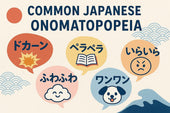
Common Japanese Onomatopoeia: Essential Words You’ll Hear Everywhere
If you spend any time in Japan, you’ll hear onomatopoeia everywhere: on TV, in everyday conversations, in manga, and ...
-

How to Say “To Increase” and “To Decrease” in Japanese: With Examples
You've noticed there are multiple ways to say “to increase” or "to decrease" in Japanese. Between transitive and intr...
-

How to Say "Police Officer" in Japanese: Common Terms and Slang
There are several ways to say "police officer" in Japanese, and each one has a different level of formality and usage...
-
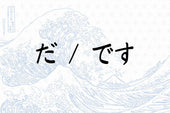
Understanding だ (da) and です (desu) in Japanese: Meaning and Usage
When learning Japanese, one of the first things you’ll come across is だ (da) and です (desu). These words don’t have a ...
-
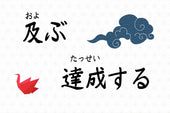
Difference Between 及ぶ (およぶ) and 達成する (たっせいする)
Both 及ぶ and 達成する can relate to "reaching" or "achieving" something, but they have distinct nuances and usage contexts...
-

JLPT N5 Study Guide: A Beginner's Roadmap to Acing the Test
If you’ve just started learning Japanese and are aiming to ace the JLPT N5, you’ll need a solid study guide to help y...
-

Beginner's Guide to Japanese Particles: Learn the Basics
TL;DR: Japanese particles are crucial for structuring sentences, acting like conjunctions or prepositions in English...
-

JLPT N5 Vocabulary List - All 748 Words You Need to Know
Vocabulary is the foundation of any language, and Japanese is no exception. The more you know, the better. Over time ...
-

JLPT N4 Kanij List - All 176 Characters You Need To Know
After mastering the JLPT N5 kanji, you're ready to take your Japanese kanji game to the next level. JLPT N4. Let's go...
-
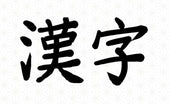
Kanji For Kanji - 漢字
Inception time. Which kanji compose the kanji of "kanji"? The kanji for "kanji" is actually pretty straightforward. I...
-
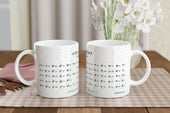
How to Memorize Katakana Easily: 9 Tips for Beginners
For those diving into Japanese, mastering hiragana and katakana is the first significant challenge. While hiragana o...
-

Complete Hiragana and Katakana Chart With All 112 Characters
The very first step for everybody who wants to learn Japanese is to study the hiragana and katakana chart (before lea...
-
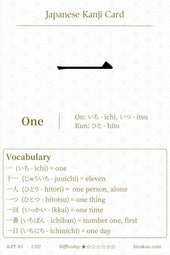
JLPT N5 Kanji: Kanji For One 一 (ichi)
Probably one the most simple kanji to remember, the kanji for 'one' is simply written '一'. Let's see its readings and...
-
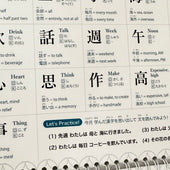
How Long Does It Take to Learn Kanji? A Beginner's Guide
Ask any Japanese student what's the scariest part of learning the language, and they'll say kanji. And they're righ...
-

Is it Necessary to Learn Kanji? The Last Answer You'll Ever Need
Many beginners in Japanese wonder whether they should really learn kanji. I know this, because I also wondered when s...
-

How Long Does it Take to Learn Hiragana and Katakana?
As a beginner in Japanese, your first step is diving into the alphabets of Hiragana and Katakana. These are the build...
-

13 Best YouTube Channels to Learn Japanese, From Beginner to Intermediate
YouTube can be an incredible resource for learning Japanese. And best of all, it's free. So we've compiled a list of ...
-
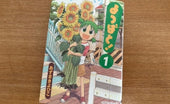
Top 10 Manga for Japanese Language Learners: From Beginners to Intermediates!
If you're learning Japanese, chances are you're interested in manga. So instead of reading texts about Tanaka-san s...
-
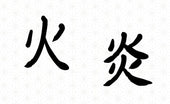
Kanji für „Feuer“ auf Japanisch: 火 oder 炎?
Willkommen zu unserer aufschlussreichen Erkundung des japanischen Kanji! Heute entfachen wir unser Verständnis ein...
-

Der vollständige Leitfaden zu Ländernamen auf Japanisch: Sagen Sie sie richtig und sprechen Sie sie richtig aus!
Egal, ob Sie eine Reise planen, Japanisch lernen oder einfach nur wissen möchten, wie verschiedene Länder in einer an...
-
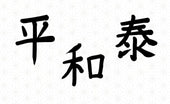
Kanji für Frieden: 平, 和, 泰 – Die Symbole der Harmonie
Sie fragen sich vielleicht, was die japanischen Symbole für „Frieden“ sind. In diesem Artikel tauchen wir tief in ...
-
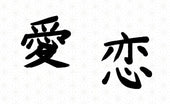
Kanji für „Liebe“: Wie und wann man 愛 und 恋 verwendet
Willkommen auf unserer Reise in die Welt des japanischen Kanji! Heute beschäftigen wir uns mit einem der herzerwär...
-
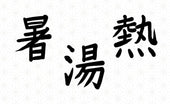
Kanji für „Hot“ auf Japanisch: 暑, 湯 und 熱 – Ein umfassender Leitfaden
Willkommen auf unserer Reise in die Welt des japanischen Kanji! Heute werden wir uns mit einem spannenden und wese...
-
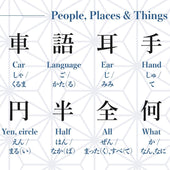
JLPT N5 Kanji-Liste – Alle 112 Zeichen, die Sie kennen müssen
Wenn Sie sich zum Ziel gesetzt haben, die JLPT N5-Prüfung zu bestehen, ist eines sicher: Ein fester Umgang mit Kanji ...

![~から~まで – Saying “From A to B” in Japanese [JLPT N5]](http://hirakan.com/cdn/shop/articles/from-AtoB.jpg?v=1765093560&width=170)
![まで – Expressing “Until” and “Up To” in Japanese [JLPT N5]](http://hirakan.com/cdn/shop/articles/until-up-to.jpg?v=1765093405&width=170)
![から – Expressing “Because” and “From/Since” in Japanese [JLPT N5]](http://hirakan.com/cdn/shop/articles/because-from_since.jpg?v=1765093285&width=170)
![や – Listing Examples with “And, Among Others” in Japanese [JLPT N5]](http://hirakan.com/cdn/shop/articles/and.jpg?v=1765093138&width=170)
![も – Saying “Also” and “Too” in Japanese [JLPT N5]](http://hirakan.com/cdn/shop/articles/mo-also-too_99f908e6-78d0-4f82-8319-391ef42764bc.jpg?v=1763787251&width=170)
![と – Linking 'And', 'With', and Quotations in Japanese [JLPT N5]](http://hirakan.com/cdn/shop/articles/to-and-with-quotation.jpg?v=1763265110&width=170)
![で – Marking Where and How an Action Happens in Japanese [JLPT N5]](http://hirakan.com/cdn/shop/articles/de-where-how-action-happens.jpg?v=1763264973&width=170)
![へ – Marking Direction ‘Toward’ in Japanese [JLPT N5]](http://hirakan.com/cdn/shop/articles/he-marking-direction.jpg?v=1762667986&width=170)
![に – Marking Time, Destinations, and Recipients in Japanese [JLPT N5]](http://hirakan.com/cdn/shop/articles/ni-marking-destination.jpg?v=1762667846&width=170)
![の – Possession and Noun Linking in Japanese [JLPT N5]](http://hirakan.com/cdn/shop/articles/no-possession-and-noun-linking.jpg?v=1761961297&width=170)
![を – Marking the Direct Object in Japanese [JLPT N5]](http://hirakan.com/cdn/shop/articles/o-direct-object.jpg?v=1761960990&width=170)
![が – Marking the Subject ('Who/What') in Japanese [JLPT N5]](http://hirakan.com/cdn/shop/articles/ga-subject-marker_60f30f70-6ca5-47ee-9a00-3646195d7d3c.jpg?v=1761386355&width=170)
![は (wa) – Topic Marker and Contrast in Japanese [JLPT N5]](http://hirakan.com/cdn/shop/articles/wa-topic-marker.jpg?v=1761385996&width=170)
![じゃない・ではありません – Expressing 'Is/Was Not' in Japanese [JLPT N5]](http://hirakan.com/cdn/shop/articles/janai-dehaarimasen_2594963b-531e-4f4d-a9b0-361010e0a720.jpg?v=1760865884&width=170)
![だ・です/だった・でした – Saying ‘to be’ in Japanese [JLPT N5]](http://hirakan.com/cdn/shop/articles/da-desu-datta-deshita_58bbc732-53fd-48da-83c7-4e477e7cc0b2.jpg?v=1760864506&width=170)























